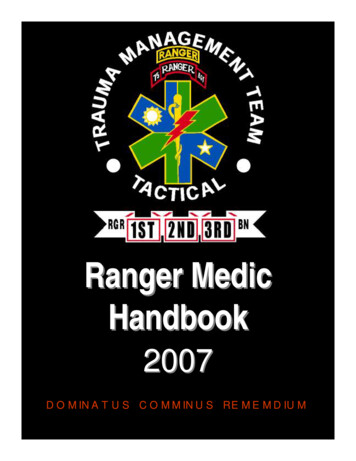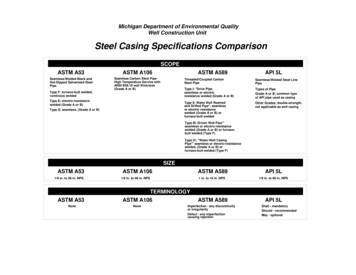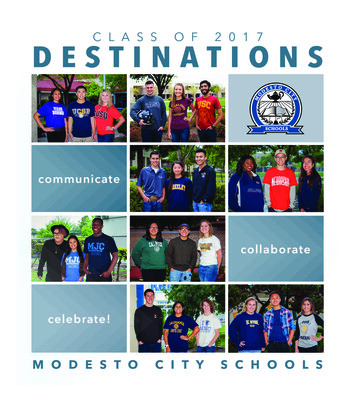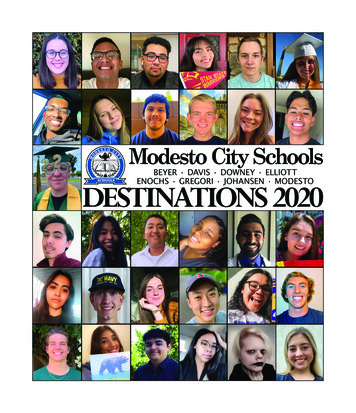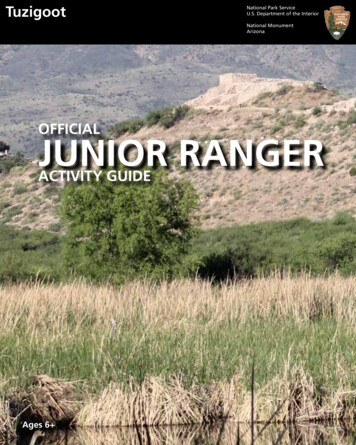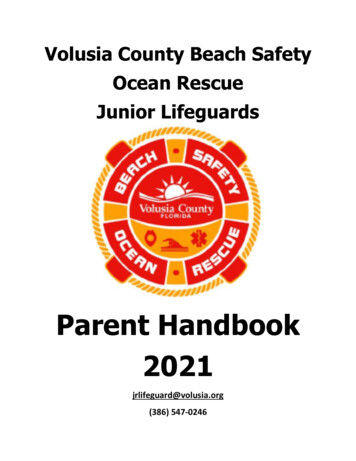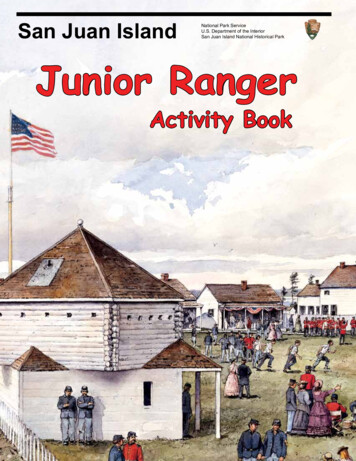
Transcription
San Juan IslandNational Park ServiceU.S. Department of the InteriorSan Juan Island National Historical ParkJunior RangerActivity Book
San Juan Island National Historical Park was established by Congress in1966. It was created to preserve and interpret American and English campsand to honor the historical events that occurred from 1853 - 1872. This parkalso illustrates how war can be averted and peace maintained through positiveactions by individuals and governments.The mission of the National Park Service is topreserve the natural and cultural resources forthe enjoyment, education and inspiration of thisand future generations. To learn more aboutAmerica’s National Parks visit www.nps.gov.Contact InformationSan Juan IslandNational Historical ParkP.O. Box 429Friday Harbor, WA 98250(360) 378-2902/2240www.nps.gov/sajh
Welcome to San Juan IslandNational Historical Park!Thank you for your interest in becoming a Junior Ranger.In this program, you will have a chance to pursue the Junior Ranger Motto:Explore, Learn, Protect!To become a Junior Ranger: Pick up an official park guide and newspaper. Watch the video. Attend a ranger-led activity or park program, or take a hikein the park. Write what you did here: Take the Junior Ranger quiz at the back of the book. Show your completed Junior Ranger Activity Book to a ranger atthe visitor center to receive your badge and certificate.Complete the same number ofactivities as your age.Note to parents: You are encouraged to join your child as she or he pursuesthe activities in this book. Don’t worry about answering all of the questionscorrectly. Appreciation of a national park starts with becoming aware of thebeauty, diversity and stories within the park you are visiting. Share yourfeelings as you explore the park. Your enthusiasm is contagious!The symbol marking the page numbers represents thepeaceful occupation of the island by the two great nationsinvolved in the Pig War.1
The Pig WarThe Pig War is really a story about peace. When pioneers first came to theSan Juan Islands, both American and British settlers thought the land belongedto their country. The confusion came from a treaty written earlier that did notspecify which of the two water channels would be the Canadian /U.S. border.In , a British pig dug up and ate some an American settlerhad planted. The American and British settlers started to quarrel about whoowned the land on which they lived. In their anger, they called forand warships to be brought to the island. While the crisis was being resolved,the British set up their camp on the northern end while the Americans stayedon the tip of the island.During the 12 years of the island, neither side fired a shot;in fact they often had parties and horse races together. To solve this dispute,the two countries asked the ruler of Germany to be the . In1872, he decided the belonged to the United States. Inthe end, the dispute was settled peacefully through diplomacy and arbitration,leaving the two camps to be preserved by the National Park Service.Place the following words in the Pig War story.PotatoesSharingArbitrator – look at the next pageSouthern1859San Juan IslandsSoldiersDirections:After reading the story,trace the strait decided byGermany as the Canadian/U.S. border.Then dot the strait the Britishwanted as the border.2
Creating PeaceSan Juan Island National Historical Park was created to celebrate the peacefulsettlement of an American-British disagreement over the Canadian/U.S. waterboundary. Three ways to settle disagreements peacefully are:NegotiationTwo parties involved ina conflict come up withan agreeable solutionbetween themselves.MediationA third party helps thetwo parties involved in aconflict come up with anagreeable solution.ArbitrationTwo parties involvedin a conflict select athird party to solvetheir disagreement.Referring to the Pig War story on the previous page, which of the aboveconflict resolution methods was used to resolve the boundary dispute?What country was involved in its resolution?Imagine your sister is always taking the TV remote and watching her favoriteshows. When you ask her for the remote so you can change the channel,she does not want to share it with you. You tell her that this makes you veryupset. How can you use each of the above methods to solve this disagreementpeacefully?You can use negotiation by:You can use mediation by:You can use arbitration by:3
1860 UniformsBoth the American and British soldiers wore uniforms. Each was unique to theircountry. They carried everything they needed on them, which included items fortheir duties as soldiers as well as everyday life.Draw a line matching what the soldiers are wearing to its name.American UniformBritish UniformThe uniform worn bythe Americans wasmostly blue, which wasconsidered the nationalcolor.The British wore ascarlet coat with brassbuttons and navy bluepants.Bed rollBayonetForage capPackCanteenShako capBelt plateBrass buttonsCap boxCap boxBrogan shoeUnion locket buckleRifleCartridge boxBayonetRifle4
FoodCompare the different daily food of the Native Americans, American soldiers andBritish soldiers. Do you see any similarities? Which diet looks the best to you? Doyou eat any of the same foods? Fill in what you eat regularly.NATIVEAMERICANSSalmonDeerElkCamas rnmealBeansCoffeeBRITISHSOLDIERSFresh meatVegetablesBiscuitsOatmealChocolateTeaYOUWhen you get home, try making hardtack, which was the main food of the Americansoldiers. The hardtack will be soft at first, but will become hard after a day or two.Be careful - if you leave it in wooden barrels like the soldiers did, you may evenget to eat some weevils for extra protein.Hardtack Recipe5 cups flour1 tablespoon baking powder1 tablespoon salt1 ¼ cups of waterPreheat oven to 450 degrees Fahrenheit. Mix ingredients in abowl until it is a stiff, elastic dough but not dry or sticky.Roll dough about ½ inch thick onto a greased cookie sheet.With a bread knife, divide the dough into 3x3 squares andpoke a grid of holes with a nail.Bake in oven for 20 minutes or until lightly browned. Let cool.5
ArchaeologyMany things used today are derived from items used hundreds, even thousandsof years ago. Trace archaeological history by filling in the empty blanks, using theword list below.PREHISTORICHISTORICCanoeWriting stickClipper shipBallpoint penOil lampNoneBentwood boxElectric lampContact lensesCast iron potBulletTwigSmall shellMODERNMissileDental flossGlass beadHemp ropeNylon ropeHole in groundFlush toiletKelp bulbBottled waterDigging stickMetal shovelWord List:BackhoeCamasFerryQuillPlastic beadTreeChamber potIndian cornKelp stalks6Ivory toothbrushSpectaclesSinewWater pitcherStoneTorchTeflon panComputerArrow
Tree RingsYou can tell how old a tree is by looking at the rings ofthe cross section. A cross section is a big round slicefrom the trunk of a fallen tree. Each ring is one year of atree’s life. The rings have different thickness dependingon the amount of rainfall that year. Also, you can seewhen a tree survived a fire by looking for pitch.Take a look at the Douglas Fir cross sectionat American Camp that fell down in the bigwinter storm of 2006.How old was it when it fell down?What year did it start growing?Now, draw a cross section of atree showing your age.Animal TracksThere are many animals that live on San Juan Island, and each has it ownunique footprint. Draw a line matching the tracks to the animal.DeerDeer mouseGreat blue heronGarter snakeRiver otter7
Prairie RestorationAmerican Camp is made up mostly of prairie. Non-native plants, like thistle andHimalayan blackberry, have crowded out many of the native grasses and wildflowerssuch as camas and buttercup that used to be very common. Native Americansburned parts of the prairie to promote the growth of camas, a bulb they used forfood. Today a prescribed fire is a way to help remove exotic plants and prepare thesite for growth of native species. Seeds collected from remaining native wildflowersand grasses are planted in the burnt area in the fall. By spring the new seedlingsappear, and within a couple of years the restored native prairie should be wellestablished.Help restore the American Camp prairie by numbering the following picturesin order.BurningPlantingRecovered8Black aftermathNew growthNon-native prairie
Use Your SensesWhen you are out on the water or hiking down a trail, your senses are telling youabout your surroundings. Today, take a moment to sit down and look, smell, feeland listen to your surroundings. We left out taste ‘cause you probably don’t want totaste the sand! Write down some examples for each of the senses.SightTouchSmellSound9
BINGOAmerican CampExplore American Camp to find at least five objects that create horizontal, verticalor diagonal rows.Pickett portrait Robert’s rockWild flowersDriftwoodButterflyBald eagleShellsRedoubtFlag poleFREELaundressquartersConeArrowheadBone harpoonpoints10LagoonSnowcappedmountains Parade groundsSlugBrass buttonOfficer quarters Doug fir slice Crockery bottleDeerCanteenFox
English CampExplore English Camp to find at least five objects that create horizontal, verticalor diagonal rows.Union flagBlock houseOsprey nestBigleaf maplePear treesBald eagleDinghy dockJuniper treeShell middenMadrona treeDeerFREESea birdOregon TeritoryMapCisternStone stairwayIron bedGuss islandPicture ofofficer’s house Formal gardenSpiderFireplaceHospitalFernShutters11
Life ZonesA habitat is home to a plant or animal. It provides the food, water, shelter and spacea species needs to survive. At San Juan Island National Historical Park, there aremany different habitats that make up diverse life zones. Each life zone is home toa variety of plants and animals.American CampAlong the southern edge of American Camp is the Strait of Juan de Fuca.This deep waterway supports a wide variety of fish and large mammals, such asthe Orca. On the shoreline is the intertidal zone. This is where many crustaceansincluding barnacles and crabs live. Above the intertidal zone is the prairie. It is alarge, open grassland with very few trees. There are many wildflowers such as thepurple camas and chocolate lilies, along with multi-colored butterflies.Label the life zones in the picture.Name these plants and animals and then place them in the correct life zone.I live in a white protectiveshell and stay on therocks. I use my featherylegs to gather food. Whenwater is low, inside I go.Who am I?12I am a large, black andwhite mammal, and I loveto dive in deep salt waterlooking for fish. I travellong distances with myfamily and friends in apod. Who am I?I have a tall purple flower thatblooms in the spring, andmy leaves look like grass.The Native Americansharvested my bulb to eatwhich is similar to a potato.Who am I?
English CampEnglish Camp has a different set of life zones. Mudflats revealed during lowtide are where marine vegetation, shellfish and small fish flourish. Low wave actionand silt deposits from streams draining into Garrison Bay create a muddy bottomthat eel grass loves. Above the mudflats on the lower edge of Young Hill is anopen woodland made up of Garry oak and Pacific madrone trees scattered on awildflower prairie. You may see a bluebird here. Above the Garry oak stand is aconiferous forest containing Douglas fir, hemlock and cedar trees. This cool, moistforest provides a good environment for other plants like ferns and moss.Label the life zones in the picture.Name these plants and animals and then place them in the correct life zone.I am a short spreadingplant that grows on rocksand the north side oftrees. I like moisture andI am usually bright green.Who am I?I live in thick bedsin muddy areas. Mylong, thin green leavesrise from a spreadingunderground stem andprovide shelter for smallfish and crabs.Who am I?I am blue and live innests in tree cavities.You will see me inwooded grassy areaslooking for insects toeat. Who am I?13
MazeWatch for dangerson your way!San JuanIsland14In January, bald eaglesmigrate from theirwinter fishing groundson the Fraser River inCanada to San JuanIsland. Can you helpthe eagle find its way?Each spring, Western bluebirdsreturn to San Juan Island fromtheir winter grounds in southernCalifornia. Can you track thebluebird’s migration path?
Create Your Own EmblemThe arrowhead is the emblem of the National ParkService. It can be found in many different placesaround the San Juan Island National HistoricalPark. Park Rangers even have one on their shirts!The buffalo symbolizes all of the wildlife, and thetrees, all of the plants. The mountains representthe land, and the arrowhead itself, the history. Ifyou were going to make your own emblem for SanJuan Island National Historical Park, what would itlook like? Would it be in the shape of an arrowheador something different?Draw your own emblem for San Juan Island NHP below. Remember to includesomething to represent the wildlife, plants, land and history. If you think thereshould be something more, add that too!15
National Park ServiceNational parks are created by the American people to preserve our history andculture and protect some of the most amazing natural wonders on earth. Parksare meant to be enjoyed by generations to come as well as today. Today there arenearly 400 National Parks in the nation. The numbers below represent the numberof NPS sites in each state or territory.What state are you from?How many National Parks do you have in your state?What are some other parks that you have visited?Shade the states and territories that you have 173290271251526 2241212811187116115
Junior Ranger QuizWhen you see wildlife in the park, you should:A. Feed it so it will come closer.B. Enjoy watching it from a distance.C. Chase it to see how fast it can run.I can help take care of San Juan Island NHP by:A. Picking up litter.B. Staying on trails.C. Both.If you see an interesting rock, arrowhead or old bottle, you should:A. Take it home.B. Throw it in the water.C. Leave it where it is.What is something new you learned?What was one of your favorite places you visited in the park?Junior Ranger PledgeAs a Junior Ranger, I, ,promise to be curious and learn as much as I can about myNational Park; protect and preserve the landscape; and helpkeep the air, land and water clean. I will share what I havelearned about National Parks with others and will continue toexplore these national treasures.
BBBBBBBBBBBBBBBDatehas achieved all requisites for becoming aJunior Ranger. Congratulations!NameFor all who see this, be it known thatSan Juan Island National Historical ParkPark RangerBBBBBBBBBB BBBBBBBBBBBB BB BBBBBBBBBBB
Along the southern edge of American Camp is the Strait of Juan de Fuca. This deep waterway supports a wide variety of fish and large mammals, such as the Orca. On the shoreline is the intertidal zone. This is where many crustaceans including barnacles and crab
